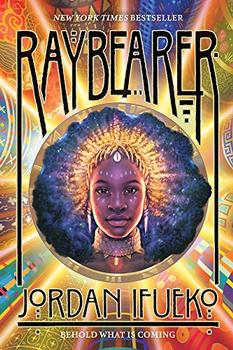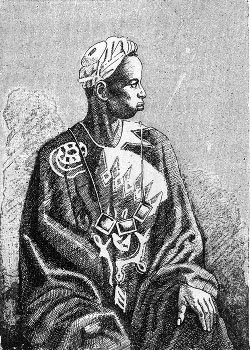Summary | Excerpt | Reviews | Beyond the Book | Read-Alikes | Genres & Themes | Author Bio

This article relates to Raybearer
 In Jordan Ifueko's fantasy debut Raybearer, Mbali, one of the Emperor's Council of Eleven, is identified as a griot – "a singer of histories and stories, the most sacred of Arit priests." Griots are not a literary invention, but an incorporation of Ifueko's Nigerian heritage into her fantasyscape, along with tutsu sprites and the culture of the Yoruba.
In Jordan Ifueko's fantasy debut Raybearer, Mbali, one of the Emperor's Council of Eleven, is identified as a griot – "a singer of histories and stories, the most sacred of Arit priests." Griots are not a literary invention, but an incorporation of Ifueko's Nigerian heritage into her fantasyscape, along with tutsu sprites and the culture of the Yoruba.
"Griot" is one name of many for a West African historian, singer, storyteller, poet or musician who sometimes also acts in an advisory capacity to a ruler. Griots are living repositories of culture, who carry, remember, recite and pass on oral histories through performance. While there are different instruments that griots might use while performing, Mbali uses a talking drum, a West African instrument consisting of two drumheads connected by leather cords. The novel's protagonist Tarasai is given a similar drum, an ancient artifact, inscribed with the words "The truth will never die, as long as griots keep beating their drums." The notion of empire is one of the book's major themes, and with it, the question of what history is and who gets to write it. As such, the concept of the griot — of living, remembered history that can be re-remembered and reclaimed, even after an attempt to stamp it out — is integral to what makes this fantasy novel so refreshingly different.
 While some might see a parallel with the bardic tradition, it's important to note here that similar does not equal "same" or "interchangeable," especially when it comes to diversity in fantasyscapes. The context matters, if only because Ifueko breaks and remakes fantasy conventions in part by infusing this novel with a different kind of worldbuilding drawing from a different kind of heritage. In an author's note at the beginning of the text, she writes: "This is the magic-infused sum of all my cultural influences…..It's the book I needed growing up: a world where coily-haired fairies grant wishes in mango orchards, cursed princes ride leopards over Asiatic mountains, and dark-skinned girls dare to challenge immortal emperors."
While some might see a parallel with the bardic tradition, it's important to note here that similar does not equal "same" or "interchangeable," especially when it comes to diversity in fantasyscapes. The context matters, if only because Ifueko breaks and remakes fantasy conventions in part by infusing this novel with a different kind of worldbuilding drawing from a different kind of heritage. In an author's note at the beginning of the text, she writes: "This is the magic-infused sum of all my cultural influences…..It's the book I needed growing up: a world where coily-haired fairies grant wishes in mango orchards, cursed princes ride leopards over Asiatic mountains, and dark-skinned girls dare to challenge immortal emperors."
For readers of the Western fantasy canon, this world will feel both familiar and new. Raybearer is a different kind of fantasy narrative that disrupts the patterns of the Oxford School of Fantasy, which arose from the tradition of writers such as J.R.R. Tolkien, Philip Pullman, C. S. Lewis, Susan Cooper and Diana Wynne Jones. This tradition is heavily inflected with medievalism, and set a pattern of fantasy construction for the writers who came up after them.
While some might say that fantasy is just fantasy, in fact, the genre is virtually always laden with politics of enchantment and wonder, which oftentimes also amount to the politics of representation: who gets to determine how fantasy is shaped and who gets to be part of magical realms and have access to power. Ifueko deftly deploys these politics in her worldbuilding, constructing the empire of Aritsar as a place where people of many backgrounds will be able to find themselves. To paraphrase the author, it's the world she wanted to inhabit when she was a young reader, woven together from various parts of her identity for other readers like her. Much like the griots in Raybearer who remember the deeper histories of Aritsar and are able to build a new world from that knowledge, so too can readers learn to imagine the world anew as they're presented with a different construction of magic, one that goes beyond the medievalist and bardic traditions.
Sengalese griot, 1890 from Côte occidentale d'Afrique by Colonel Henri Nicolas Frey
West African talking drum
Filed under Books and Authors
![]() This "beyond the book article" relates to Raybearer. It originally ran in August 2020 and has been updated for the
August 2021 paperback edition.
Go to magazine.
This "beyond the book article" relates to Raybearer. It originally ran in August 2020 and has been updated for the
August 2021 paperback edition.
Go to magazine.
The silence between the notes is as important as the notes themselves.
Click Here to find out who said this, as well as discovering other famous literary quotes!
Your guide toexceptional books
BookBrowse seeks out and recommends the best in contemporary fiction and nonfiction—books that not only engage and entertain but also deepen our understanding of ourselves and the world around us.